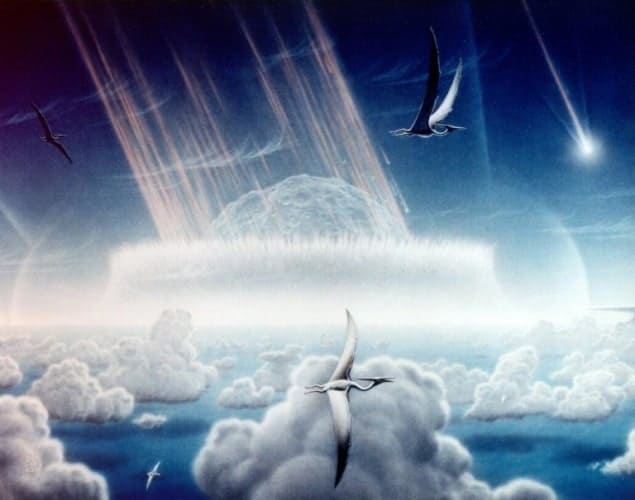
A mid-sized asteroid impact with the ocean could drastically deplete the ozone layer for many years, according to a team of US researchers. Such damage would expose the surface to levels of UV radiation up to three times more severe than anything currently recorded on Earth.
While large asteroids, such as the 15 km space rock implicated in the demise of the dinosaurs, are notorious for their destructive power, mid-sized asteroids, with diameters between 100 m and 1 km, also have the potential to inflict global damage to the biosphere. Conventional models have focused on mid-sized ocean strikes, analysing immediate effects, such as tsunamis, or climatic changes due to large amounts of dust ejected into the atmosphere. Now, a group of researchers, led by Elisabetta Pierazzo at the Planetary Science Institute in Arizona, US, are the first to model the effects on the ozone layer from a mid-sized asteroid ocean impact.
Pierazzo and her colleagues envisaged the fall-out from two separate mid-latitude impact scenarios: a 500 m diameter asteroid and one measuring 1 km, both hitting a 4 km deep ocean at 18 km s–1. Using a 3D shock physics model, it was found that 4.4 × 1012 kg and 4.2 × 1013 kg of water, a combination of liquid and vapour, would be ejected 1000 km into the atmosphere in the respective cases. A separate model was then used to predict the effect of this water on the chemistry and dynamics of the atmosphere, taking into account factors such incident UV radiation, auroral processes and ion drag.
Injecting chlorine and bromine
“You’re not just injecting water, you’re injecting sea water, which includes elements such as chlorine and bromine. These cause the ozone to become very reactive and be destroyed by their presence,” Pierazzo told physicsworld.com.
The model was run to simulate several years after impact and the results suggest significant, long-lasting damage to the ozone layer. For the larger impact the team found that: ozone depletion would reach more than 70% for more than two years at mid-high latitudes; there would be worldwide depletion of over 50% for more than a year; both hemispheres would experience continuous ozone depletion of greater than 40% for 3.5 years. “The effect is comparable to the recent ozone depletion caused by CFCs. Except, rather than being restricted to polar regions, it would be global, we’d see it everywhere: both at high and low latitudes,” Pierazzo explained.
With the ozone layer’s ability to block harmful UV radiation impaired, the biosphere would be significantly affected; changes to both plant growth and molecular DNA are among the possible consequences. Food production could also be negatively hit; estimates based on the CFC ozone hole suggest a 16% drop in ozone could cause a 5% drop in phytoplankton levels in the ocean, having the knock-on effect of reducing fishery yields by 7% or 7 million tonnes of fish per year.
Direct dangers
Humans would also be subject to direct dangers. The intensity of UV radiation, which commonly causes sunburn, is measured on the International UV Index (UVI). Radiation reaching values of 11 is classified as “extreme” and likely to cause sunburn within minutes. The highest UVI score ever recorded on Earth is 20 in the Puna de Atacama, in the Argentinian Andes; Pierazzo’s model predicts widespread UVI values of more than 20 for the first two years up to latitudes of 70°, peaking at a UVI of 56 around 27 °N after the 1 km impact.
These findings add to the immediate effects already modelled by previous studies to create a bigger picture of the aftermath of a mid-sized asteroid ocean strike. “As well as the effects outlined in this work, a 1 km asteroid hitting the ocean would strike with as much energy as 50,000 megatonnes of TNT. It would open a crater in the water over 15 km wide, creating a tidal wave with a peak height of almost 40 m,” Joanna Morgan, geophysicist at Imperial College, London, told physicsworld.com.
However, such events are likely to be rare. “A 1 km asteroid impact has not happened in recorded human history. But, such events are thought to have occurred in Earth’s past, probably with a frequency of roughly once every million years or so,” explained Alan Fitzsimmons, a near-Earth asteroid researcher at Queen’s University in Belfast.
The findings are presented in Earth and Planetary Science Letters (doi:10.1016/j.epsl.2010.08.036).



